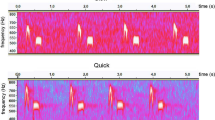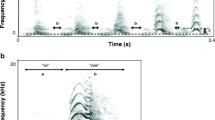Abstract
It is generally thought that attractive male traits are positively correlated with dominance (aggressiveness). However, growing evidence suggests that this is not necessarily the case. We investigated whether calling song, a male mating display used by females to evaluate potential mates in a field cricket (Gryllus integer), is correlated with aggressiveness. In this species, females prefer males with longer durations of singing time. We measured singing time by measuring song over three continuous days using a custom-designed audio-monitor and assessed aggressiveness by pairing males in agonistic interactions. Our results showed that for males caught in the field, the percentage of time spent singing was negatively correlated with aggressiveness. However, in males that were raised in the laboratory, the percentage of time spent singing was not correlated with aggressiveness. Since calling duration is an attractive male trait in these crickets, our data show that the attractiveness of males can be either negatively related to aggressiveness (field) or unrelated to aggressiveness (lab). Neither of these results fit the traditional view that preferred male mating cues should be positively correlated with dominance (aggressiveness). These results also suggest that measurements of aggressiveness made in the lab do not necessarily correspond with aggressiveness in the field.


Similar content being viewed by others
References
Adamo SA, Hoy RR (1995) Agonistic behavior in male and female field crickets, Gryllus bimaculatus, and how behavioral context influences its expression. Anim Behav 49:1491–1501
Anderson DR (2008) Model-based inference in the life sciences. Springer, New York
Blanckenhorn W, Dixon AFG, Fairbairn DJ, Foellmer MW, van der Gibert P, Linde K, Meier R, Nylin S, Pitnick S, Schoff C, Signorelli M, Teder T, Wiklund (2007) Proximate causes of Rensch's rule: does sexual size dimorphism in arthropods result from sex differences in development time? Am Nat 169:245–257
Bolker BM (2008) Ecological models and data in R. Princeton University Press, Princeton
Forsgren E (1997) Female sand gobies prefer good fathers over dominant males. Proc R Soc B 264:1283–1286
Hedrick AV (1986) Female preferences for male calling bout duration in a field cricket. Behav Ecol Sociobiol 19:73–77
Hedrick AV (1988) Female choice and the heritability of attractive male traits—an empirical study. Am Nat 132:267–276
Hedrick AV (2000) Crickets with extravagant mating songs compensate for predation risk with extra caution. Proc R Soc B 267:671–675
Hedrick AV, Mulloney B (2004) A multichannel electronic monitor of acoustic behaviors, and software to parse individual channels. J Neurosci Methods 133:201–210
Hofmann H (2001) Assessment of strength and willingness to fight during aggressive encounters in crickets. Anim Behav 62:337–348
Izzo AS, Tibbetts E (2012) Spotting the top male: sexually selected signals in male Polistes dominulus wasps. Anim Behav 83:839–845
Kortet R, Hedrick A (2005) The scent of dominance: female field crickets use odour to predict the outcome of male competition. Behav Ecol Sociobiol 59:77–83
Kortet R, Hedrick A (2007) A behavioural syndrome in the field cricket Gryllus integer: intrasexual aggression is correlated with activity in a novel environment. Biol J Linn Soc 91:475–482
Leonard AS, Hedrick AV (2010) Long-distance signals influence assessment of close range mating displays in the field cricket, Gryllus integer. Biol J Linn Soc 100:856–865
Luong L, Kortet R, Hedrick A (2005) Prevalence and intensity of Cephalobium microbivorum (Nematoda: Diplogasteridia) infection of three species of Gryllus field crickets. Parasitol Res 97:336–339
McGhee KE, Fuller RC, Travis J (2007) Male competition and female choice interact to determine mating success in the bluefin killifish. Behav Ecol 18:822–830
Niemela P, Vainikka A, Lahdenpera S, Kortet R (2012) Nymphal density, behavioral development, and life history in a field cricket. Behav Ecol Sociobiol 66:645–652
Ophir A, Galef B (2003) Female Japanese quail that “eavesdrop” on fighting males prefer losers to winners. Anim Behav 66:399–407
Polkii M, Kortet R, Hedrick A, Rantala M (2013) Dominance is not always an honest signal of male quality but females may be able to detect the dishonesty. Biol Lett 9:2012100
Qvarnstrom A (1997) Experimentally increased badge size increases male competition and reduces male parental care in the collared flycatcher. Proc R Soc B 264:1225–1231
Qvarnstrom A, Forsgren E (1998) Should females prefer dominant males? Trends Ecol Evol 13:498–501
R Development Core Team (2011). R: A language and environment for statistical computing. R Foundation for Statistical Computing, Vienna, Austria. ISBN 3-900051-07-0, URL http://www.R-project.org/.
Rodriguez-Munoz R, Bretman A, Slate J, Walling CA, Tregenza T (2010) Natural and sexual selection in a wild insect population. Science 328:1269–1272
Savage K, Hunt J, Jennions M, Brooks R (2005) Male attractiveness covaries with fighting ability but not with prior fight outcome in house crickets. Behav Ecol 16:196–200
Shackleton MA, Jennions MD, Hunt J (2005) Fighting success and attractiveness as predictors of male mating success in the black field cricket, Teleogryllus commodus: the effectiveness of no-choice tests. Behav Ecol Sociobiol 58:1–8
Wong BBM, Candolin U (2005) How is female mate choice affected by male competition? Biol Rev 80:559–571
Acknowledgments
This work was funded by the National Science Foundation (grant IOS-0716332 to A.H.) We thank Raine Kortet and several anonymous reviewers for comments. The work described here complies with the current laws of the USA.
Author information
Authors and Affiliations
Corresponding author
Additional information
Communicated by D. Gwynne
Rights and permissions
About this article
Cite this article
Hedrick, A., Bunting, J. An attractive male trait and aggressiveness are negatively correlated in wild field crickets, but uncorrelated in lab-reared crickets. Behav Ecol Sociobiol 68, 233–238 (2014). https://doi.org/10.1007/s00265-013-1638-y
Received:
Revised:
Accepted:
Published:
Issue Date:
DOI: https://doi.org/10.1007/s00265-013-1638-y




